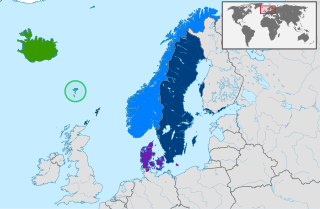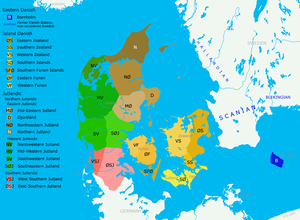
Demographic features of the population of the Faroe Islands include population density, ethnicity, education level, health of the populace, economic status, religious affiliations and other aspects of the population. The vast majority of the population are ethnic Faroese, of North Germanic descent. Ethnic Faroese are, in genetic terms, among the most homogenous groups ever found.

Greenland is a North American autonomous territory of the Kingdom of Denmark. It is the largest country within the Kingdom and one of three countries which form the Kingdom, the others being Denmark proper and the Faroe Islands; the citizens of all three countries are citizens of Denmark. As Greenland is one of the Overseas Countries and Territories of the European Union, citizens of Greenland are also granted European Union citizenship. The capital and largest city of Greenland is Nuuk. Greenland lies between the Arctic and Atlantic oceans, east of the Canadian Arctic Archipelago. It is the world's largest island, as well as the northernmost area of the world – Kaffeklubben Island off the northern coast is the world's northernmost undisputed point of land, and Cape Morris Jesup on the mainland was thought to be so until the 1960s.

Scandinavia is a subregion of Northern Europe, with strong historical, cultural, and linguistic ties between its constituent peoples. Scandinavia most commonly refers to Denmark, Norway, and Sweden. It can sometimes also refer more narrowly to the Scandinavian Peninsula. In English usage, Scandinavia is sometimes used as a synonym for Nordic countries. Iceland and the Faroe Islands are sometimes included in Scandinavia for their ethnolinguistic relations with Sweden, Norway and Denmark. While Finland differs from other Nordic countries in this respect, some authors call it Scandinavian due to its economic and cultural similarities.

Denmark is a Nordic country in the central portion of Northern Europe. It is the metropolitan part of and the most populous constituent of the Kingdom of Denmark, a constitutionally unitary state that includes the autonomous territories of the Faroe Islands and Greenland in the North Atlantic Ocean. Metropolitan Denmark is the southernmost of the Scandinavian countries, lying south-west and south of Sweden, south of Norway, and north of Germany, with which it shares a short border, Denmark's only land border.

The North Germanic languages make up one of the three branches of the Germanic languages—a sub-family of the Indo-European languages—along with the West Germanic languages and the extinct East Germanic languages. The language group is also referred to as the Nordic languages, a direct translation of the most common term used among Danish, Faroese, Icelandic, Norwegian, and Swedish scholars and people.

The northern region of Europe has several definitions. A restrictive definition may describe Northern Europe as being roughly north of the southern coast of the Baltic Sea, which is about 54°N, or may be based on other geographical factors such as climate and ecology.

The flag of the Faroe Islands is an offset cross, representing Christianity. It is similar in design to other Nordic flags – a tradition set by the Dannebrog of Denmark, of which the Faroe Islands are an autonomous territory.

The Inatsisartut, also known as the Parliament of Greenland in English, is the unicameral parliament of Greenland, an autonomous territory in the Danish realm. Established in 1979, it meets in Inatsisartut, on the islet of Nuuk Center in central Nuuk.

Kalaallisut, also known as West Greenlandic, is the primary language of Greenland and constitutes the Greenlandic language, spoken by the vast majority of the inhabitants of Greenland, as well as by thousands of Greenlandic Inuit in Denmark proper. It was historically spoken in the southwestern part of Greenland, i.e. the region around Nuuk.

Danish language exonyms for non-Danish speaking locations exist, primarily in Europe, but many of these are no longer commonly used, with a few notable exceptions. Rom (Rome), Lissabon, Sankt Petersborg and Prag (Prague) are still compulsory, while e.g. Venedig is more common than Venezia (Venice). In the decades following World War II, there has been a strong tendency towards replacing Danish exonyms with the native equivalent used in the foreign country itself. Possibly this is because many of these Danish forms were imported from German.
The Faroese language conflict is a phase in the history of the Faroe Islands in the first half of the 20th century. It was a political and cultural argument between advocates of Faroese and Danish to serve as the official language of the Faroe Islands.

The Danish Realm, officially the Kingdom of Denmark, is the area over which the monarch of Denmark is head of state. It consists of metropolitan Denmark—the kingdom's territory in continental Europe and sometimes called "Denmark proper" —and the realm's two autonomous regions: the Faroe Islands in North Atlantic and Greenland in North America. The relationship between the three parts of the Kingdom is also known as The unity of the Realm.
A non-binding referendum on Greenland's autonomy was held on 25 November 2008 to support or oppose the Greenland Self-Government Act. It was passed with 75% approval and a 72% turnout. The non-binding referendum was on expanded home rule in 30 areas, including police, courts, and the coast guard; gave Greenland a say in foreign policy; provided a more definite split of future oil revenue; and made the Greenlandic language the sole official language.

Denmark–Norway was an early modern multi-national and multi-lingual real union consisting of the Kingdom of Denmark, the Kingdom of Norway, the Duchy of Schleswig, and the Duchy of Holstein. The state also claimed sovereignty over three historical peoples: Frisians, Gutes and Wends. Denmark–Norway had several colonies, namely the Danish Gold Coast, the Nicobar Islands, Serampore, Tharangambadi, and the Danish West Indies. The union was also known as the Dano-Norwegian Realm, Twin Realms (Tvillingerigerne) or the Oldenburg Monarchy (Oldenburg-monarkiet).

Greenlandic independence is a political ambition of some political parties, advocacy groups, and individuals of Greenland, an autonomous territory within the Kingdom of Denmark, to become an independent sovereign state.

Danish Greenlanders are ethnic Danes residing in Greenland and their descendants.

Greenlandic people in Denmark are residents of Denmark with Greenlandic or Greenlandic Inuit heritage. According to StatBank Greenland, as of 2020, there were 16,780 people born in Greenland living in Denmark, a figure representing almost one third of the population of Greenland. According to a 2007 Danish government report, there were 18,563 Greenlandic people living in Denmark. The exact number is difficult to calculate because of the lack of differentiation between Greenlandic and Danish heritage in Danish government records and also due to the fact that the way in which people identify themselves is not always a reflection of their birthplace. As of 2018, there were 2,507 Greenlanders enrolled in education in Denmark.
Danish Argentines are Argentine citizens of Danish ancestry or people who have emigrated from Denmark and reside in Argentina. Danish immigration to Argentina was particularly intense between the late 19th century and early 20th century. It is estimated that between 1857 and 1930 about 18,000 Danes settled in Argentina. The wave of Danish immigration to Argentina was the third largest in the world, behind those in the United States and Australia, making it one of the largest Danish communities in the world. They also include Faroese and Greenlandic Argentines because of Faroe Islands' and Greenland's status as an autonomous territory of Denmark.

The Faroese independence movement, or the Faroese national movement, is a political movement which seeks the establishment of the Faroe Islands as a sovereign state outside of Denmark. Reasons for independence include the linguistic and cultural divide between Denmark and the Faroe Islands as well as their lack of proximity to one another; the Faroe Islands are about 990 km (620 mi) from Danish shores.
The Danish language is the official language in Denmark. In the Faroe Islands, the Faroese language and the Danish language are the official languages, and both must be taught in schools. Danish should be used in court, but Faroese can be used in all other official places. The Greenlandic language is the official language in Greenland, and Greenland's Home Rule Act of 2009 does not require Danish to be taught or the use of Danish for official purposes. In accordance with Denmark's official monolingualism, all official documents and communications are in Danish.


















